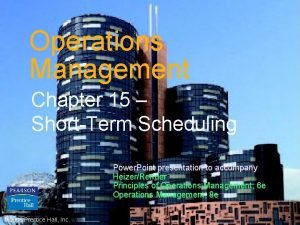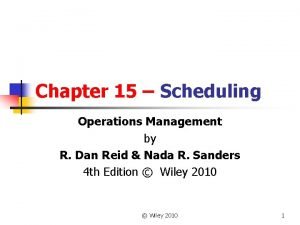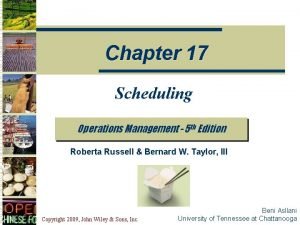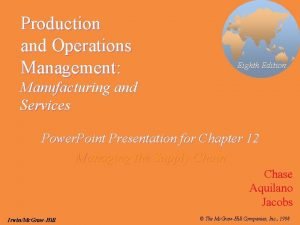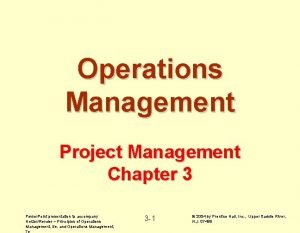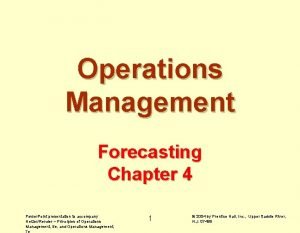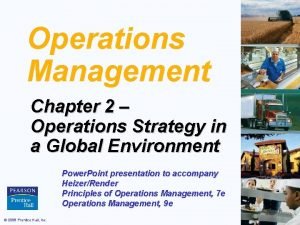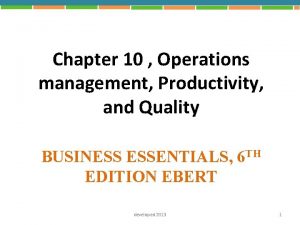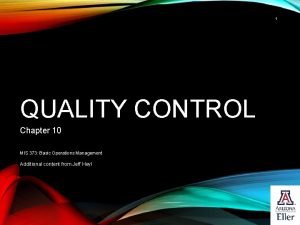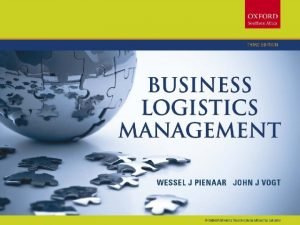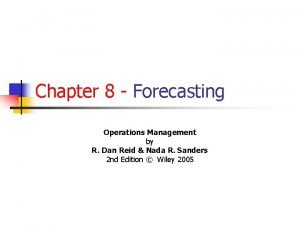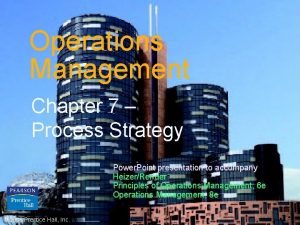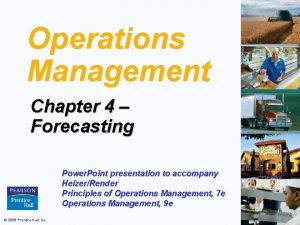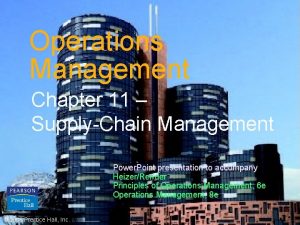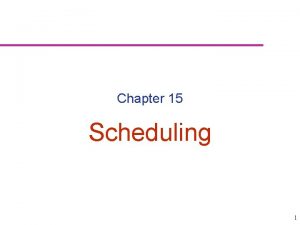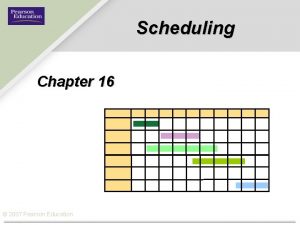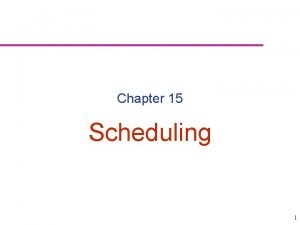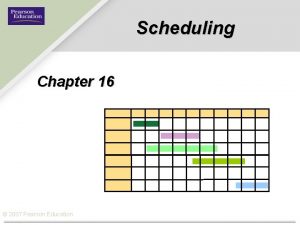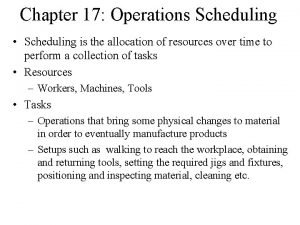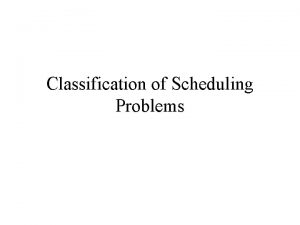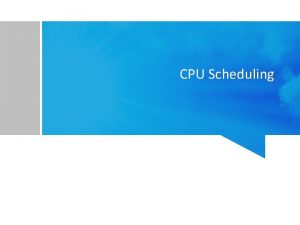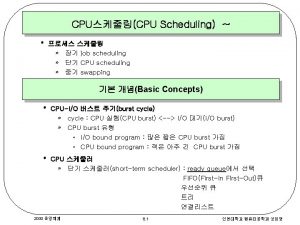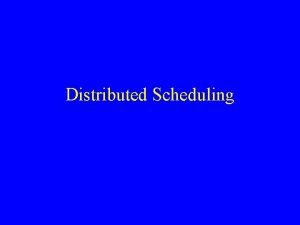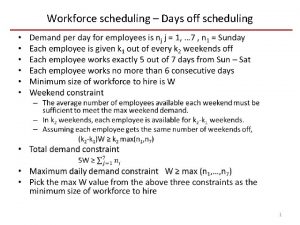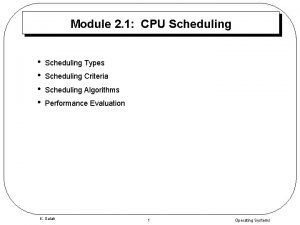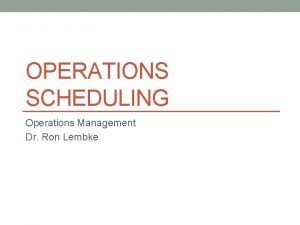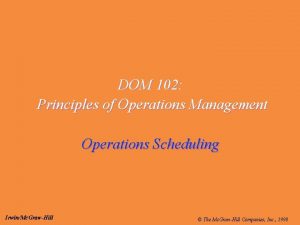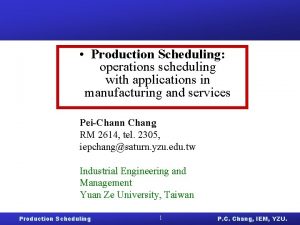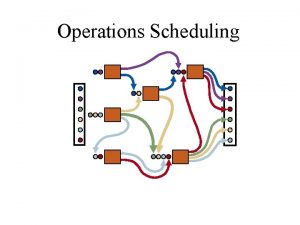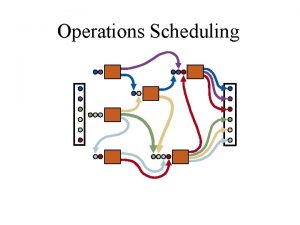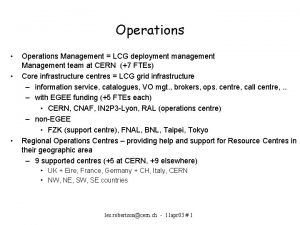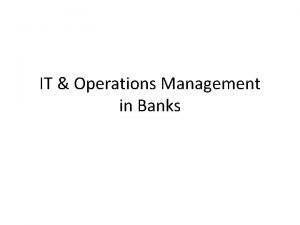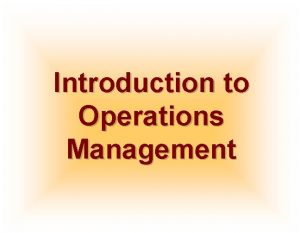Chapter 17 Scheduling Operations Management 5 th Edition























- Slides: 23

Chapter 17 Scheduling Operations Management - 5 th Edition Roberta Russell & Bernard W. Taylor, III Copyright 2009, John Wiley & Sons, Inc. Beni Asllani University of Tennessee at Chattanooga

Lecture Outline w w w Objectives in Scheduling Loading Sequencing Monitoring Advanced Planning and Scheduling Systems w Theory of Constraints Copyright 2009, John Wiley & Sons, Inc. 2

What is Scheduling? w Scheduling - specifies when labor, equipment, facilities are needed to produce a product or provide a service w Last stage of planning before production occurs w Loading – assignment of jobs to process centers w Sequencing – determining the order in which jobs will be processed Copyright 2009, John Wiley & Sons, Inc. 3

Scheduled Operations w Process Industry n n Linear programming EOQ with non-instantaneous replenishment w Mass Production n n Assembly line balancing w Project n w Batch Production Project -scheduling techniques (PERT, CPM) Copyright 2009, John Wiley & Sons, Inc. n Aggregate planning Master scheduling Material requirements planning (MRP) Capacity requirements planning (CRP) 4

Objectives in Scheduling w Meet customer due dates w Minimize job lateness w Minimize response time w Minimize completion time w Minimize time in the system Copyright 2009, John Wiley & Sons, Inc. w Minimize overtime w Maximize machine or labor utilization w Minimize idle time w Minimize work-inprocess inventory 5

Loading w Process of assigning work to limited resources w Perform work on most efficient resources w Use assignment method of linear programming to determine allocation Copyright 2009, John Wiley & Sons, Inc. 6

Sequencing § Prioritize jobs assigned to a resource § If no order specified use first-come first -served (FCFS) § Many other sequencing rules exist § Each attempts to achieve to an objective Copyright 2009, John Wiley & Sons, Inc. 7

Sequencing Rules § § § § § FCFS - first-come, first-served LCFS - last come, first served DDATE - earliest due date CUSTPR - highest customer priority SETUP - similar required setups SLACK - smallest slack CR - critical ratio SPT - shortest processing time LPT - longest processing time Copyright 2009, John Wiley & Sons, Inc. 8

Critical Ratio Rule CR considers both time and work remaining CR = time remaining work remaining = due date - today’s date remaining processing time If CR > 1, job ahead of schedule If CR < 1, job behind schedule If CR = 1, job on schedule Copyright 2009, John Wiley & Sons, Inc. 9

Sequencing Jobs Through One Process w Flowtime (completion time) n Time for a job to flow through the system w Makespan n Time for a group of jobs to be completed w Tardiness n Difference between a late job’s due date and its completion time Copyright 2009, John Wiley & Sons, Inc. 10

Simple Sequencing Rules JOB PROCESSING TIME DUE DATE A B C D E 5 10 2 8 6 10 15 5 12 8 Copyright 2009, John Wiley & Sons, Inc. 11

Simple Sequencing Rules: FCFS START SEQUENCE TIME A B C D E 0 5 15 17 25 PROCESSING COMPLETION DUE TIME DATE 5 10 2 8 6 Copyright 2009, John Wiley & Sons, Inc. 5 15 17 25 31 10 15 5 12 8 TARDINESS 0 0 12 13 23 12

Simple Sequencing Rules: DDATE START SEQUENCE TIME C E A D B 0 2 8 13 21 PROCESSING COMPLETION DUE TIME DATE 2 6 5 8 10 Copyright 2009, John Wiley & Sons, Inc. 2 8 13 21 31 5 8 10 12 15 TARDINESS 0 0 3 9 16 13

Simple Sequencing Rules: SLACK START SEQUENCE TIME E C D A B 0 6 8 16 21 A(10 -0) – 5 = 5 B(15 -0) - 10 = 5 C(5 -0) – 2 = 3 D(12 -0) – 8 = 4 E(8 -0) – 6 = 2 PROCESSING COMPLETION DUE TIME DATE 6 2 8 5 10 Copyright 2009, John Wiley & Sons, Inc. 6 8 16 21 31 8 5 12 10 15 TARDINESS 0 3 4 11 16 14

Simple Sequencing Rules: CR CR START SEQUENCE TIME E D B A C 0 6 14 24 29 A(10)/5 = 2. 00 B(15)/10 = 1. 50 C (5)/2 = 2. 50 D(12)/8 = 1. 50 E (8)/6 = 1. 33 PROCESSING COMPLETION DUE TIME DATE 6 8 10 5 2 Copyright 2009, John Wiley & Sons, Inc. 6 14 24 29 31 8 12 15 10 5 TARDINESS 0 2 9 19 26 15

Simple Sequencing Rules: SPT START SEQUENCE TIME C A E D B 0 2 7 13 21 PROCESSING COMPLETION DUE TIME DATE 2 5 6 8 10 Copyright 2009, John Wiley & Sons, Inc. 2 7 13 21 31 5 10 8 12 15 TARDINESS 0 0 5 9 16 16

Simple Sequencing Rules: Summary RULE AVERAGE COMPLETION TIME FCFS DDATE SLACK CR SPT 18. 60 15. 00 16. 40 20. 80 14. 80 Copyright 2009, John Wiley & Sons, Inc. AVERAGE NO. OF MAXIMUM TARDINESS JOBS TARDY TARDINESS 9. 6 5. 6 6. 8 11. 2 6. 0 3 3 4 4 3 23 16 16 26 16 17

Sequencing Jobs Through Two Serial Process Johnson’s Rule 1. List time required to process each job at each machine. Set up a one-dimensional matrix to represent desired sequence with # of slots equal to # of jobs. 2. Select smallest processing time at either machine. If that time is on machine 1, put the job as near to beginning of sequence as possible. 3. If smallest time occurs on machine 2, put the job as near to the end of the sequence as possible. 4. Remove job from list. 5. Repeat steps 2 -4 until all slots in matrix are filled and all jobs are sequenced. Copyright 2009, John Wiley & Sons, Inc. 18

Johnson’s Rule JOB PROCESS 1 PROCESS 2 A B C D E 6 11 7 9 5 8 6 3 7 10 E Copyright 2009, John Wiley & Sons, Inc. A D B C 19

Johnson’s Rule (cont. ) E E A 5 A D D B C B 11 Process 1 (sanding) C 20 31 38 Idle time E 5 A 15 D 23 B 30 Process 2 (painting) C 37 41 Completion time = 41 Idle time = 5+1+1+3=10 Copyright 2009, John Wiley & Sons, Inc. 20

Guidelines for Selecting a Sequencing Rule 1. 2. 3. 4. 5. 6. SPT most useful when shop is highly congested Use SLACK for periods of normal activity Use DDATE when only small tardiness values can be tolerated Use LPT if subcontracting is anticipated Use FCFS when operating at low-capacity levels Do not use SPT to sequence jobs that have to be assembled with other jobs at a later date Copyright 2009, John Wiley & Sons, Inc. 21

Monitoring w Work package n Shop paperwork that travels with a job w Gantt Chart n Shows both planned and completed activities against a time scale w Input/Output Control n Monitors the input and output from each work center Copyright 2009, John Wiley & Sons, Inc. 22

Theory of Constraints w w Not all resources are used evenly Concentrate on the” bottleneck” resource Synchronize flow through the bottleneck Use process and transfer batch sizes to move product through facility Copyright 2009, John Wiley & Sons, Inc. 23
 Johnson's rule
Johnson's rule Operations scheduling definition
Operations scheduling definition Scheduling loading sequencing and monitoring
Scheduling loading sequencing and monitoring Job scheduling vs process scheduling
Job scheduling vs process scheduling Operations management eighth edition
Operations management eighth edition Chapter 12 inventory management
Chapter 12 inventory management Using mis (10th edition) 10th edition
Using mis (10th edition) 10th edition Using mis 10th edition
Using mis 10th edition Managing front office operations 10th edition
Managing front office operations 10th edition Quality management in operations management
Quality management in operations management What is tqm
What is tqm Management robbins coulter 14th edition chapter 1
Management robbins coulter 14th edition chapter 1 Operations management chapter 3 solutions
Operations management chapter 3 solutions Operations management chapter 4 forecasting solutions
Operations management chapter 4 forecasting solutions Chapter 2 operations management
Chapter 2 operations management Introduction to operation management
Introduction to operation management Process selection in operations management
Process selection in operations management Operations management chapter 10
Operations management chapter 10 Asq control chart
Asq control chart Chapter 8 operations management
Chapter 8 operations management Operations management chapter 3 forecasting solutions
Operations management chapter 3 forecasting solutions Cross over charts
Cross over charts Operation management chapter 4
Operation management chapter 4 Chapter 11 operations management
Chapter 11 operations management
